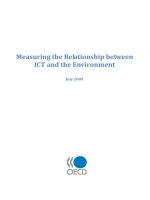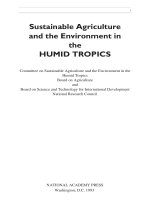aggregate and the environment
Bạn đang xem bản rút gọn của tài liệu. Xem và tải ngay bản đầy đủ của tài liệu tại đây (8.16 MB, 68 trang )
ooperative
planning
by developers,
government,
and citizens is the
key to successful
protection and
utilization of
aggregate
resources.
AGI gratefully acknowledges the AGI Foundation
and the U.S. Geological Survey for their support of
this book and of the Environmental Awareness Series.
For more information about this Series please see
the inside back cover.
A G I
E N V I R O N M E N T A L
William H. Langer
Lawrence J. Drew
Janet S. Sachs
With a Foreword by
Travis L. Hudson and
Philip E. LaMoreaux
American Geological Institute
in cooperation with
U.S. Geological Survey
A W A R E N E S S
S E R I E S,
8
About the Authors
William H. Langer has been a research geologist
with the U.S. Geological Survey (USGS) since 1971,
and has been the USGS Resource Geologist for
Aggregate since 1976. He is a member of the Society
for Mining, Metallurgy, and Exploration (SME), the
American Society for Testing and Materials committees
for Concrete Aggregate and Road and Paving
Materials, and the International Association of
Engineering Geologists Commission No. 17 on
Aggregates. He has conducted geologic mapping
and field studies of aggregate resources throughout
much of the United States. He has published over
100 reports, maps, and articles relating to crushed
stone and gravel resources including monthly
columns about geology and aggregate resources
in Aggregates Manager and Quarry.
Lawrence J. Drew has nearly 40 years of
experience working on mineral and petroleum
assessment and environmental problems in private
industry and with the federal government. Since
joining the U.S. Geological Survey in 1972, he has
worked on the development of assessment techniques
for undiscovered mineral and petroleum resources.
He is the author of many publications including a
column for Nonrenewable Resources in which he
explored ideas about the environment and the extraction and use of natural resources. Recently, he has
written on the environmental concerns inherent with
the production of natural aggregate.
Janet S. Sachs has more than 33 years of
experience as a technical scientific editor and writer
with the federal government. She has been with the
U.S. Geological Survey since 1975, and she has
edited and designed numerous publications,
including U.S. Geological Survey Yearbooks and
National Water Summaries.
Foreword 4
It Helps To Know
Preface 5
Why Aggregate Is Important 9
7
What the Environmental
Concerns Are 12
How Science Can Help 12
The Hidden Costs and Benefits 14
Producing
and Transporting
Aggregate 17
Managing Physical Disturbance 34
Reclamation 47
Aggregate Deposits and Sources 18
Minimizing Impacts from Blasting 36
Recycling 50
Controlling Dust and Noise 38
Regulatory Foundations of
Stewardship 51
Sand and Gravel 19
Crushed Stone 22
Aggregate Producers 24
The Exploration Process 24
Aggregate Mining 25
Mining Sand and Gravel 26
Mining Crushed Stone 26
Protecting
the Environment
33
Dust Control 38
Noise Control 40
Protecting Water Resources 42
Surface Water and
Stream Channels 42
Providing
for the Future
47
Environmental Risk and Management
Systems 52
Balancing our Needs 53
Case Study, Toelle County, UT 54
Groundwater 43
Processing Aggregate 28
Transporting Aggregate 30
Glossary 58
Credits 59
References 60
Sources of Additional Information 61
Index 63
AGI Foundation 64
The American Geological Institute (AGI) is a nonprofit federation of 43 scientific and
professional associations that represent more than 120,000 geologists, geophysicists, and
other earth scientists. Founded in 1948, AGI provides information services to geoscientists,
serves as a voice of shared interests in our profession, plays a major role in strengthening
geoscience education, and strives to increase public awareness of the vital role the
geosciences play in mankind’s use of resources and interaction with the environment.
The Institute also provides a public-outreach web site, www.earthscienceworld.org.
To purchase additional copies of this book or receive an AGI publications catalog
please contact AGI by mail or telephone, send an e-mail request to ,
or visit the online bookstore at www.agiweb.org/pubs.
American Geological Institute
4220 King Street
Alexandria, VA 22302
(703) 379-2480
www.agiweb.org
Copyright 2004 by American Geological Institute
All rights reserved. ISBN: 0-922152-71-3
Project Management: Julia A. Jackson, GeoWorks
Design: DeAtley Design
Printing: Ries Graphics
Sand, gravel, and crushed stone — the main types of natural aggregate — are essential
resources for use in construction. Today, aggregate production accounts for about half of the nonfuel-mining volume in the United States. In the future, the rebuilding of deteriorated roads, highways, bridges, airports, seaports, waste disposal and treatment facilities, water and sewer systems,
and private and public buildings will require enormous quantities of aggregate to be mined.
An area’s geology, land ownership, land use, and transportation infrastructure are factors
that affect aggregate supply. Although potential sources of sand, gravel, and crushed stone are
widespread and large, land-use choices, economic considerations, and environmental concerns
may limit their availability.
Making aggregate resources available for our country’s increasing needs will be an
ongoing challenge. Understanding how sand, gravel, and crushed stone are produced and how
the related environmental impacts are prevented or mitigated can help citizens, communities,
and our nation meet this challenge.
This Environmental Awareness Series publication has been prepared to give the general
public, educators, and policy makers a better understanding of environmental concerns related
to aggregate resources and supplies. The American Geological Institute produces this Series
in cooperation with its 43 Member Societies and others to provide
a non-technical geoscience framework considering environmental
questions. Aggregate and the Environment was prepared under
the sponsorship of the AGI Environmental Geoscience Advisory
Committee with support from the U.S. Geological Survey and the
AGI Foundation. Other titles in the AGI Environmental Awareness
Series are listed on the inside back cover, and they are available
from the American Geological Institute.
Travis L. Hudson, AGI Director of Environmental Affairs
Philip E. LaMoreaux, Chair, AGI Environmental Geoscience
Advisory Committee
4
Many of us tend to take natural resources for granted, especially aggregate – sand, gravel,
and crushed stone. On one hand, aggregate resources are vital to our way of life because they
are the major raw materials used in construction of roads, rail lines, bridges, hospitals, schools,
airports, factories, and homes. On the other hand, the mining and processing of natural
resources such as aggregate commonly raises concerns about potential environmental impacts.
Nevertheless, we must have access to a readily available supply of high quality aggregate if we
wish to maintain our current lifestyle. Given the right information and access to suitable resources
in appropriate geologic settings, aggregate producers can meet the nation’s demand for
aggregate without causing undue harm to the environment. We do not need to choose between
aggregate development and the environment. The question is how to achieve a balance among
the economic, social, and environmental aspects of aggregate resource development.
This book is designed to help you understand our aggregate resources — their importance,
where they come from, how they are processed for our use, the environmental concerns related
to their mining and processing, how those concerns are addressed, and the policies and
regulations designed to safeguard workers, neighbors, and the environment from the negative
impacts of aggregate mining. We hope this understanding will
help prepare you to be involved in decisions that need to be
made — individually and as a society — to be good stewards
of our aggregate resources and our living planet.
We are grateful to the many individuals and organizations
who provided illustrations and other forms of support for
the project, and for the technical reviews provided by many
colleagues in industry, academia, and state and federal agencies.
Those colleagues included John Hayden, Travis Hudson,
John Keith, Phil LaMoreaux, Marcus Milling, Steve Testa, and
Jan van Sant. The authors thank the following individuals for
their technical input to this document: Belinda Arbogast,
Nicole Cline, Wallace Bolen, Daniel Knepper, David Lindsey,
Michael Sheahan, Valentin Tepordei, and Bradley VanGosen.
Our special thanks go to Julia A. Jackson, GeoWorks, for
her editorial assistance, and to Julie DeAtley, DeAtley Design,
for her superb graphic design. This document truly would not
have come together without their hard work. Finally, we would
like to acknowledge the American Geological Institute for
the opportunity to produce this publication, and the
U.S. Geological Survey for its support.
William H. Langer
Lawrence J. Drew
Janet S. Sachs
July, 2004
5
T A M P A,
A
6
F L O R I D A
ggregate is the foundation of our nation.
I T
H E L P S
U S
T O
1
K N O W
C O M M O D I T Y
VA L U E S
Fig. 1. At $14.4 billion,
the value of aggregate dwarfs
other nonfuel commodities.
$14.4
It
aggregate
$2.9
2003
$2
$1.2
$1
gold copper iron salt
Commodities valued at less
14
12
10
$
than $1 billion, such as zinc,
lead, silver, and peat, are
8 Billions
of Dollars
6
4
2
not shown.
0
is impossible to construct a city without using natural aggregate — sand, gravel,
and crushed stone. The amount of these essential construction materials we use each year
is likely to surprise you. Annual production of aggregate worldwide totals about 16.5 billion
tons (15 billion metric tons). This staggering volume valued at more than $70 billion makes
aggregate production one of the most important mining industries in the world (Fig. 1).
What becomes of these earth materials? Aggregate is used to build and maintain urban,
suburban, and rural infrastructures including commercial and residential buildings; highways,
bridges, sidewalks, and parking lots; factories and power generation facilities; water storage,
filtration, and delivery systems; and wastewater collection and treatment systems. Developed
countries cannot sustain their high level of productivity, and the economies of developing
nations cannot be expanded, without the extensive use of aggregate.
Aggregate consists of grains or fragments of rock (Fig. 2). These materials are mined
or quarried, and they are used either in their natural state or after crushing, washing,
A G G R E G A T E
crushed
stone
Fig. 2. Sand and gravel are rock
fragments shaped and rounded by erosion.
gravel
Machines make crushed stone by breaking
rock into small angular pieces.
sand
7
and sizing. Sand, gravel, and crushed
uneconomical. Therefore, aggregate
stone are commonly combined with binding
operations commonly are located near
media to form concrete, mortar, and
population centers and other market areas.
Even though natural aggregate is wide-
asphalt. They also provide the base that
underlies paved roads, railroad ballast,
ly distributed throughout the world, it is not
surfaces on unpaved roads, and filtering
necessarily available for use. Some areas
material in water treatment.
do not have sand and gravel, and potential
Unlike metals, such as gold, that
sources of crushed stone may occur at
have a high “unit value” derived from their
depths that make extraction impractical.
special properties and relatively low abun-
In other areas, natural aggregate does not
dance, aggregate is a high-bulk, low unit
meet the quality requirements for use, or it
value commodity. Aggregate derives much
may react adversely when used in such
of its value from being located near the
applications as concrete or asphalt.
market and thus is said to have a high
Furthermore, an area may contain abundant
“place value.” Transporting aggregate
aggregate suitable for the intended
long distances can increase its price signifi-
purpose, but conflicting land uses, zoning,
cantly and may render distant deposits
regulations, or citizen opposition may
1900
preclude its development and production.
Total U.S. population
76 million
(40% urban, 60% rural)
Per capita consumption of
aggregate
0.5 tons per year
1902
First reinforced
concrete skyscraper
(Ingalls Building
Cincinnati, OH)
210 ft. tall
1916
245,000 miles railroad
1922-1926
1891
1870
Standard Zoning
Enabling Act of 1922
First concrete street
in America
(Bellefontaine, OH)
53,000 miles railroad
1904
First survey of public
roads. Out of 2 million
miles of roads, only
154,000 are surfaced.
The rest are dirt.
A G G R E G A T E
1870-2000
Fig. 3. In little more than 100 years,
U.S. population has nearly quadrupled and
per capita use of aggregate has increased
8
from ½ ton to 10 tons per year.
1920
8 million cars in U.S.
All of these factors — high place value,
were the primary means of transporting of
the need to locate operations close to the
goods, and roads were generally in poor
market, the limited distribution of aggre-
condition (Fig. 3). As the nation’s highway
gate, and the limited access to aggregate
system grew throughout the 20th century, so
— complicate the process of producing
did the demand for aggregate. Today, how-
aggregate and increase the desirability of
ever, aggregates touch nearly every aspect
planning for future supplies.
of our lives, not just as highways (Fig. 4).
2000
Per capita consumption
of aggregate
10 tons per year
Why Aggregate Is Important
The use of aggregate in the United States
Total U.S. population
281 million
(75% urban, 25% rural)
1973
is tied closely to the history of road building.
Colorado House Bill
to protect dwindling
aggregate resources
Until the early 1900s, railroads and canals
1956
Dwight D. Eisenhower
signs Federal-Aid
Highway Act of 1956
1950
over 40 million
cars in U.S.
1950
Total U.S. population
151 million
(60% urban, 40% rural)
2000
over 132 million cars
and 4 million miles
of roads in U.S.
1947
Start of mass
produced
communities
(Levittown, NY)
A G G R E G A T E
U S E D
I N
O N E
H O U S E
229 tons
Basement Foundation
Drain around Foundation
Fig. 4. It is estimated that
39 tons
22 tons
Basement Floor
25 tons
229 tons of aggregate is needed
for a 1,000 square foot ranch
house, (or a 2,000 square-foot
two story house), with a full,
unfinished basement.
Sidewalk
14 tons
Half the street in
front of the house
Driveway
100 tons
19 tons
Garage Floor
10 tons
9
Fig. 5.
Maintaining our
urban infrastructure
requires enormous
amounts of
aggregate.
10
We are born in hospitals constructed
dams, many of which are constructed from
from natural aggregate. We live our lives
concrete. Coal-fired electric power plants
dependent on an infrastructure created
are built of concrete and use unbound natu-
out of concrete and asphalt-bound natural
ral aggregate (crushed limestone) to scrub
aggregate (Fig. 5). And after we die, our
flue gases of pollutants. Aggregate makes it
remains are likely to be interred for eternity
possible to construct and enhance all of the
in a vault of concrete.
structures in our lives: our schools, offices,
In general, employment in urban and
supermarkets and department stores; our
suburban areas is defined by the workplace
homes, neighborhood streets, sidewalks,
and transportation structures built with sand,
and curbs; our sports arenas, recreational
gravel, and stone and tailored to our needs.
centers, natural park facilities, and bike
Nearly all commercial activity is transacted
trails; and our places of worship.
in buildings and on highway, air, rail, and
Aggregate, or more properly crushed
marine systems that require concrete and
stone, also has numerous agriculture and
asphalt-bound structures comprised almost
industrial uses. Pulverized stone is used in
totally of aggregate. In volume, aggregate
fertilizers and insecticides to enhance the
Fig. 6.
comprises about 85 percent of these struc-
growth of plants (Fig. 6) and to process that
Minerals from
tures; the binder (portland cement in con-
food and fiber; in the manufacture of phar-
crushed stone
crete and bitumen in asphalt pavement) and
maceuticals, from antacids to life-saving
help ensure
the reinforcing skeletons made of structural
drugs; in the manufacture of sugar, glass,
healthy crops.
steel comprise the remaining 15 percent.
paper, plastics, floor coverings, rubber,
Life in our urban and suburban worlds
leather, synthetic fabrics, glue, ink, crayons,
depends on supplies of water that are
shoe polish, cosmetics, chewing gum, and
collected behind dams and transported
toothpaste, and the list goes on and on.
through aqueducts and tunnels constructed
Stone in one form or another is used in
or lined with aggregate in the form of
practically everything that we touch during
concrete. The human waste generated in
the day.
urban and suburban life requires a complex
of transport and treatment facilities that are,
in large part, built of concrete. Unbound
natural aggregate is widely used in the
waste-water filtration part of these systems.
Hydroelectric power (10 percent of U.S.
total electric power) is based on systems of
11
Our need for construction aggregate
is increasing. Figure 7 shows the historical
and estimated future use of construction
the immediate vicinity of an aggregate
operation by using available technology.
In certain locations, for example in
aggregate in the Unites States until the year
active stream channels, karst areas
2025. It is projected that in the United
(landscapes formed primarily through the
States we will use almost as much construc-
dissolving of rock), and some groundwater
tion aggregate in the next 25 years as we
systems, the geologic characteristics of
20th
the site raise environmental concerns.
used in the entire
century. Aggregate
is needed to repair existing infrastructure,
Aggregate recovery may change the
create new infrastructure for the nation’s
geologic conditions, and potentially
growing population, and to meet the
alter the dynamic equilibrium of a given
demands of changing lifestyles for bigger
environment. Some ecosystems underlain
and better houses and more, bigger,
with aggregate serve as habitat for rare
and better highways. Meeting these needs
or endangered species. Similarly, some
depends on the availability of large
geomorphic features are themselves rare
supplies of aggregate.
examples of geologic phenomena or
processes. Although aggregate extraction
What the Environmental
Concerns Are
may be acceptable in such areas, it should
Operations associated with aggregate
tion and only when properly managed to
extraction and processing are the principal
avoid potential undesirable environmental
causes of environmental concerns about
consequences.
be conducted only after careful considera-
sand, gravel, and crushed stone production,
including
! Increased dust, noise, and vibrations;
! Increased truck traffic near aggregate
operations;
! Visually and physically disturbed
landscapes and habitats; or
! Affected surface or groundwater.
The geologic, hydrologic, vegetative,
climatic, and man-made characteristics
of an area largely determine the potential
environmental impacts of aggregate
How Science Can Help
Scientific and technological advances
increase the understanding of the natural
and engineering processes that lead to
environmental problems and provide sound
foundations for solving them. As our
knowledge advances, so does our ability
to prevent environmental impacts and
to correct those that do occur or have
occurred. Science and technology
can help to
! Identify high-quality natural aggregate
production. Effects such as dust, noise,
resources to meet society’s growing
and vibrations are typical of nearly any
demand for durable road surfaces,
construction project. These impacts
buildings, and other facilities;
commonly can be controlled, mitigated,
or kept at tolerable levels and restricted to
! Provide sound, unbiased scientific
information to the permitting process to
allow better-informed decision-making;
12
H O W
M U C H
A G G R E G AT E
I S
U S E D
Y O U R
O N
B E H A L F ?
To visualize the 10 tons
of aggregate used for each
person in the United States
each year, imagine stopping
by your local home supply
center to pick up a 50-pound
bag of landscaping rock,
every day of the week for 365
days. At the end of one year
you’d still be 35 bags short.
Fig. 7
A G G R E G AT E
U S E
P R O J E C T I O N
3.5
3.0
2.0
1.5
1.0
.5
Year
5
5
20
2
5
20
1
5
20
0
5
19
9
5
19
8
19
7
5
19
6
5
19
5
5
19
4
5
19
3
5
19
2
5
19
1
5
0
19
0
Billions of Tons
2.5
Fig. 7. It is projected
that we will use as
much aggregate
in the next 25 years as
we have used in the
previous 100 years.
13
! Identify potential environmental impacts
Once development has occurred, the
of extracting and transporting natural
value of the improvements probably will
aggregate and determine methods to
permanently prevent any further develop-
avoid or minimize impacts;
ment of aggregate at that location.
! Investigate the performance of recycled
As a result, new aggregate operations
aggregates or other materials to deter-
may be located long distances from the
mine if they can be substituted for natural
markets. The additional expense of the
aggregate, thus reducing the waste of
longer transport of resources must be
concrete, stone, and asphalt from old
passed on to consumers. For example, a
structures, as well as conserving natural
city of 100,000 residents can expect to pay
aggregate sources;
an additional $1.3 million every year for
! Provide vital information for planning
each 10 miles (16 kilometers) that the
for the availability of aggregate; and
aggregate it uses must be hauled. Also,
! Provide essential data for implementing
new deposits may be of inferior quality
the reclamation of mined-out areas.
compared with the original source, yet they
are used to avoid the expense of importing
The Hidden Costs
and Benefits
high-quality material from a more-distant
Many urban areas grow without any
offset by decreased durability of the final
consideration of the presence of a resource
product.
or an analysis of the impact of its loss. In
The benefits of aggregate development
addition to covering valuable undeveloped
are dispersed over very large areas, but the
aggregate resources, urban growth often
community where extraction occurs experi-
encroaches upon established aggregate
ences a combination of economic benefits
operations (Fig. 8). Some residents in the
and local disruptions. If regional benefits
vicinity of pits and quarries object to the
are not considered in a local permitting
dust, noise, and truck traffic associated with
process, and if the resource operation is
an aggregate operation. Other citizens may
denied, regional costs, such as longer haul
object because they are not aware of the
routes that result in more truck traffic, noise,
community’s need for aggregate or because
accidents, and more hydrocarbons released
their personal need for aggregate materials
to the atmosphere, generally increase. Any
is minor. This “not in my back yard”
gain by a local community from stopping
syndrome may restrict aggregate develop-
resource development is likely to be at the
ment. In addition, local regulations may
expense of the greater public, the greater
prohibit mining.
environment, and the region where extrac-
Natural aggregate, especially sand
14
source. Any savings for aggregate may be
tion ultimately takes place. A question
and gravel, commonly occurs in areas that
to be considered when a political entity is
are also favorable for other land uses.
evaluating whether or not to develop a
Prime aggregate resources are precluded
resource is this: How can we be sure that
from development if permanent structures
the regional benefits of making a resource
such as roads, parking lots, houses, or
available are adequately weighed in the
other buildings, are built over them.
final decision?
N
atural aggregate,
especially sand and
gravel, commonly
occurs in areas that
are also favorable
for other land uses.
U R B A N
G R O W T H
A F F E C T S
A G G R E G A T E
O P E R A T I O N S
Fig. 8. As urban growth
surrounds an aggregate
operation, the risk of
unwanted environmental
impacts increases.
15
S A N
A
ggregate
occurs
where
nature
places it.
16
F R A N C I S C O
P R O D U C I N G
A N D
T R A N S P O R T I N G
A G G R E G A T E
E
very state except Delaware produces crushed stone, and all 50 states produce
2
sand and gravel. To keep up with the ever-increasing demand, the aggregate industry has
evolved from a relatively inefficient, hand-power oriented process to a highly mechanized,
efficient industry (Fig. 9). Aggregate production essentially turns big rocks into little rocks
and carefully sorts them by size. Excavating crushed stone or sand and gravel is dependent
on the geologic characteristics and the extent and thickness of the deposit. Open-pit mining
and quarrying methods commonly are used, although some stone is mined underground.
Quarrying and mining stone generally requires drilling and controlled blasting before the
rock is extracted with power shovels, bulldozers, and draglines. Sand and gravel deposits
commonly are excavated with conventional earth-moving equipment such as bulldozers,
front-end loaders, and tractor scrapers, but may be excavated from streams or water-filled
pits with draglines or from barges that use hydraulic or ladder dredges.
Processing of quarried rock and large gravel may require crushing, depending on the
Fig. 9.
Aggregate
production
continues to
requirements for the final product. After crushing, the aggregate is sorted to size. Silt and clay
become more
are removed by washing. At this stage, aggregate commonly is moved by conveyors to bins
mechanized
or is stockpiled by size. Finally, aggregate is loaded on trucks, railcars, barges, or freighters
and efficient.
for shipment to the site of use.
17
Stream Valley
Deposits
Glaciated Areas
Alluvial Basins
beneficial use, is the final step of aggregate
Aggregate Deposits
and Sources
production. The rock outcrops and water in
Although the sources of natural aggregate
some quarries provide a natural setting that
are widespread, they are not universally
fulfills a demand for scenic, lake-front prop-
available for use. Large areas have no grav-
erty. Reclaimed pits or quarries have been
el, and underlying bedrock that might be a
converted to many uses including residential
source of crushed stone may be so deeply
developments, recreational areas, wildlife
buried that mining is impractical. The
areas, botanical gardens, golf courses,
sources of aggregate may not meet the strict
farmland, industrial and commercial proper-
chemical or physical quality requirements
ties, storm-water management, office parks,
for current or future use. Communities lack-
and landfills. Reclamation commonly is
ing local aggregate sources generally face
planned before mining begins, allowing the
the costly alternatives of importing aggre-
pit or quarry to be developed in a manner
gate from outside the area or substituting
that facilitates final reclamation.
another material for aggregate.
Reclamation, returning the land to a
18
P O T E N T I A L
S O U R C E
A R E A S
O F
Fig. 10. Although every
state contains potential
sources of sand and gravel,
Coastal Plains
Stream Valley Deposits
it may not be economically
or environmentally advisable to develop certain
Sand & Gravel
Deposits
deposits.
Aggregate is produced from materials
formed by geologic processes on and within
nature of potential aggregate sources
in an area.
the Earth’s crust. Sand and gravel created
by the process of erosion may have been
deposited thousands of years ago — only
an instant in geologic time. Granite may
have formed over a billion years ago when
molten magma deep within the Earth cooled
and solidified. Limestone may have been
deposited as coral in an ancient sea
hundreds of millions of years ago. Basalt
may have formed just yesterday as molten
lava flowing from a volcano cooled and
solidified. When an aggregate supply is
required, geological investigations can
Sand and Gravel
Sand and gravel deposits are products
of erosion of bedrock and the subsequent
transport, abrasion, and deposition of the
particles. Water and glacial ice are the
principal geologic agents that affect the
distribution of deposits of sand and gravel.
Consequently, gravel is widely distributed
and abundant near present and past rivers
and streams, in alluvial basins, and in
previously glaciated areas (Fig. 10).
determine the location, distribution, and
19
Throughout the United States, sand
and gravel are widely distributed as stream-
and are transported down steep-gradient
channel and terrace deposits. Bedrock
streams to the adjacent basins. When the
exposed near the surface of the Earth under-
flood water reaches a basin, it spreads
goes weathering and is progressively broken
out of the stream channel and deposits
into smaller and smaller pieces. The harder,
sediments in the shape of a fan (Fig. 11b).
more-resistant minerals remain as fragments
These fans, referred to as alluvial fans,
that combine with the silt and clay particles
contain thick deposits of unconsolidated
and organic materials to form soil.
material including large boulders, cobbles,
Gravity — commonly with the aid
pebbles, sand, silt, and clay. Some of
of water — moves soil material down from
this material provides useful sources
the mountains or other high areas and it
of aggregate.
accumulates in stream valleys (Fig. 11).
Many of the extensive sand and gravel
Streams pick up the particles and in the
deposits in the northern and higher-eleva-
process of transporting them, subject
tion regions of the United States are prod-
the particles to abrasion and rounding.
ucts of either continental or alpine glacia-
Eventually, stream-transported material is
tions. Glaciers leave deposits of till, an
deposited on floodplains. Stream deposits
unsorted mix of clay, sand, gravel, and
consisting of sand and gravel may be
boulders. Although till is quite widespread
suitable for aggregate, but deposits of
in glaciated areas, it commonly contains a
silt and clay are not suitable.
large amount of fine material. Thus, till gen-
As a river or stream cuts its channel
deeper, older channel and floodplain
erally is not suitable for use as aggregate.
As glacial ice melts, rock particles that
deposits standing above the modern
had been crushed, abraded, and carried
floodplain may be preserved as terraces
by the ice can be picked up and carried by
(Fig. 11a). Some stream terraces can
water melting from the glaciers (Fig. 11c).
be sources of sand and gravel. Stream-
The particles carried along in glacial
transported material deposited in the oceans
meltwater streams, are abraded, rounded,
may be dredged for use as aggregate,
and deposited much like particles carried by
if it is of the proper size and quality.
nonglacial streams. Much of the sand and
During the infrequent but torrential
floods typical of desert environments, rock
20
fragments are eroded from mountains
gravel deposited by glacial meltwater
streams can be used as aggregate.
Terraces
Erosion in Mountains
a
Point bar
Terrace
Floodplain
Deposition in Ocean
Alluvial Fan
b
Fig. 11. Sand and gravel are formed by geologic
processes. (a) Rivers or streams have deposited sand
and gravel widely throughout the United States as
Glacial Outwash
stream-channel or terrace deposits. (b) Many valley
basins in the arid and semiarid western United States
contain thick fan-shaped deposits of unconsolidated
clay, silt, sand, or gravel. These alluvial fans were
deposited during torrential floods. (c) Glacial meltwater transports particles. Finer materials are deposit-
c
ed in lakes and ponds, while the coarser sand and
gravel is deposited in and along stream channels.
21
T Y P E S O F
C R U S H E D
S T O N E
71%
Limestone
15%
Granite
7%
Other
7%
Traprock
22
Crushed Stone
Bedrock, the source material for crushed
stone, is classified on the basis of origin
as sedimentary, igneous, or metamorphic
(Fig 12). Sedimentary rocks form by
consolidation of loose sediment by
chemical, biochemical, or mechanical
processes. Chemically or biochemically
deposited carbonate sedimentary rocks,
such as hard, dense limestone (calcium
carbonate) and dolomite (calciummagnesium carbonate), commonly are
referred to as “limestone” in the aggregate
industry. Generally these rocks make good
sources of crushed stone (Fig. 12a),
however, some are too soft and absorptive,
or may contain too much poor quality
material to yield high-quality aggregate.
Chert, also known as flint, is a tough finegrained sedimentary rock made of quartz.
Chert is used as aggregate but it may react
with adverse consequences when used
in concrete. Hard, dense sandstone, a
mechanically-deposited sedimentary rock,
is occasionally used as crushed stone.
Many igneous rocks are hard, tough,
and dense, and they make excellent crushed
P O T E N T I A L
S O U R C E
A R E A S
O F
Limestone
a
Fig. 12. The geographical distribution of
rock types suitable for crushed stone as
well as production and transportation costs
affect construction costs. Hard, dense
Granite
rocks, such as limestone (a), granite (b),
Limestone
Granite
and traprock (c), are generally good
sources of crushed stone.
Traprock
b
Traprock
stone for construction uses. However, some
surface and cools and solidifies
igneous rocks are chemically reactive when
relatively quickly. These igneous rocks
used as aggregate in concrete. Igneous
commonly are referred to as “traprock”
rocks solidify from naturally occurring
in the aggregate industry (Fig. 12c).
molten rock (magma) generated within the
c
Metamorphic rocks form when existing
Earth, and they are classified further by their
rocks are subjected to heat and pressure
origin, composition, and grain size. Hard,
within the Earth. Some metamorphic rocks
coarse-grained rocks form from molten
are hard, tough, and dense and can be
magma that cools slowly deep within the
used as aggregate. These include gneiss
Earth. There rocks commonly are referred
(a banded crystalline rock); marble
to as “granite” in the aggregate industry
(metamorphosed limestone), and quartzite
(Fig. 12b). Fine-grained volcanic rocks form
(metamorphosed sandstone).
as molten lava flows onto the Earth’s
23









